Address
AVSSO 2242 SE 171st AVE Portland Oregon USA 97233
Work Hours
Monday to Friday: 7AM - 7PM
Weekend: 10AM - 5PM
Address
AVSSO 2242 SE 171st AVE Portland Oregon USA 97233
Work Hours
Monday to Friday: 7AM - 7PM
Weekend: 10AM - 5PM
Discover 15 powerful healing spell herbs to grow in your witch's apothecary garden. Boost protection and wellness with these Healing Spell Herbs.

Cultivating a witch’s apothecary garden is a meaningful way to connect with nature and enhance your magical practices. Healing Spell Herbs play a crucial role in this setup, offering a natural approach to wellness and spellwork.
By incorporating protective herbs into your garden, you can create a sanctuary that not only fosters personal growth but also provides a potent source of magical ingredients. This article will explore 15 essential herbs for your witch’s apothecary, highlighting their benefits and uses in spellwork and wellness rituals.
Herbal witchcraft has been a cornerstone of magical practices for centuries, weaving together the natural world and spiritual rituals. This ancient art combines the healing properties of plants with the mystical aspects of witchcraft, creating a powerful tool for modern practitioners.
The historical connection between witchcraft and herbalism is deep-rooted, with evidence of herbal remedies dating back to ancient civilizations. Herbalism was not just about healing; it was also intertwined with spiritual practices and magical rituals. Witches were often the keepers of this knowledge, using their understanding of herbs to create potions, salves, and spells.
“Herbs have been used in witchcraft for their medicinal properties, spiritual significance, and ability to amplify magical intentions.”
Modern witches cultivate their own herbs for several reasons. Firstly, growing their own Healing Spell Herbs allows them to connect with nature and tap into the magical properties of the plants. Secondly, it provides them with a sense of autonomy and control over their magical practice. By cultivating their own herbs, witches can ensure the quality and potency of the plants used in their spells and rituals.
By understanding the historical context and benefits of cultivating their own herbs, modern witches can deepen their practice and enhance their magical workings.
The art of creating a witch’s apothecary garden involves selecting the right healing spell herbs, tools, and techniques to foster a magical and healing environment. This process not only enhances your magical practice but also connects you with nature.

Choosing the right location for your apothecary garden is crucial. It should receive adequate sunlight and be protected from harsh winds. Consider the soil quality and drainage to ensure your healing spell herbs thrive.
To cultivate a successful apothecary garden, you’ll need a set of essential tools and supplies. These include gardening gloves, a trowel, compost, and irrigation tools. Having the right equipment will make maintaining your garden easier and more efficient.
Planning the layout of your apothecary garden is vital for maximizing space and promoting healthy growth. Consider companion planting, where certain herbs are grown together to enhance their properties. A well-planned layout will also make it easier to access and harvest your healing spell herbs.
By carefully selecting the location, gathering essential tools, and planning your garden layout, you can create a thriving and magical apothecary garden that supports your witchcraft practice.
The magical properties of healing spell herbs are a fascinating aspect of herbal witchcraft, offering insights into how these plants can be used to amplify spellwork and rituals. Healing spell herbs have been used for centuries in various magical traditions, not just for their physical healing properties but also for their ability to influence the spiritual and emotional realms.
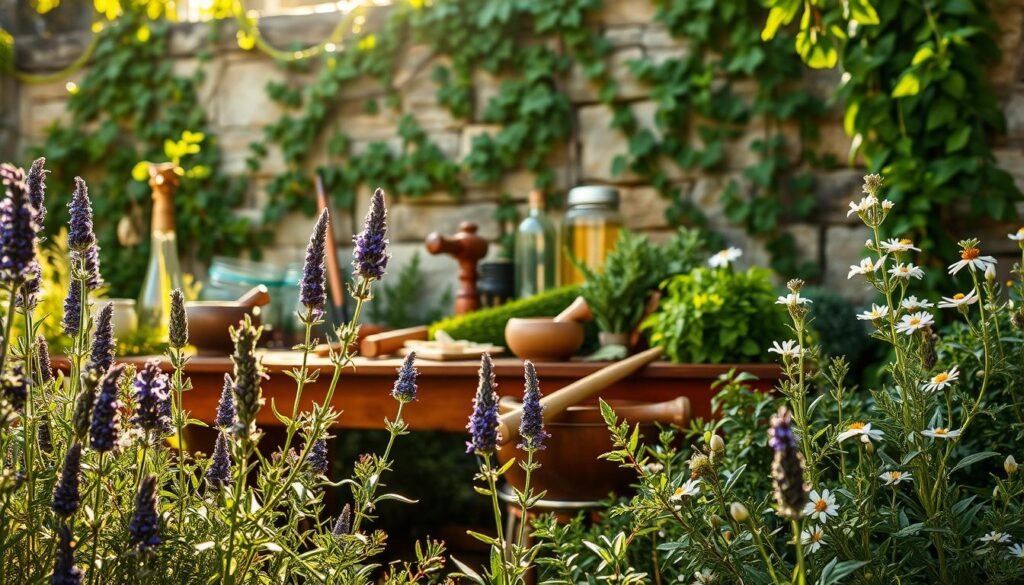
Healing spell herbs are believed to possess unique energetic properties that can be leveraged in magical workings. These properties are thought to interact with the practitioner’s energy, enhancing the effectiveness of spells and rituals. For instance, herbs like lavender are known for their calming energy, which can be used to promote peace and relaxation in spellwork.
| Herb | Energetic Property | Magical Use |
|---|---|---|
| Lavender | Calming | Promotes peace and relaxation |
| Rosemary | Stimulating | Enhances mental clarity and focus |
| Chamomile | Soothing | Used for healing and calming emotions |
Healing spell herbs can significantly enhance magical workings by adding their unique energetic properties to spells and rituals. By incorporating these herbs into magical practices, practitioners can tap into the natural world, amplifying their intentions and manifestations. For example, using chamomile in a spell can promote emotional healing, while rosemary can enhance mental clarity and focus.
In conclusion, understanding the magical properties of healing spell herbs is crucial for effective spellwork. By recognizing and harnessing the energetic properties of these herbs, practitioners can elevate their magical practices, achieving more profound and meaningful results.
In the world of herbal witchcraft, certain plants are renowned for their ability to protect and shield practitioners from harm. These protective herbs have been used for centuries to create magical barriers, safeguarding homes, sacred spaces, and individuals from negative energies and malevolent entities.

Rosemary is a versatile herb known for its protective qualities, particularly in guarding thresholds. It’s believed to ward off negative energies and promote a sense of clarity and purification.
Rosemary thrives in well-drained soil and full sun. Harvest its leaves as needed, or prune the plant to encourage new growth.
Sage is revered for its cleansing properties, making it an ideal herb for protective magical workings. It’s used to purify spaces, objects, and individuals of negative energies.
Sage prefers dry, well-drained soil and full sun. Harvest its leaves during the morning, after the dew has dried but before the heat of the day.
Rue is a potent herb used to break hexes and protect against negative magic. It’s believed to have a strong protective energy that repels malevolent forces.
Rue grows well in dry conditions and requires minimal care. Harvest its leaves and stems with caution, as the plant can cause skin irritation in some individuals.
Blackthorn is associated with protection and defense, often used in magical workings to create a shield against negative energies.
Blackthorn is a hardy shrub that thrives in a variety of conditions. Harvest its stems and berries with care, as the plant is thorny.
Rowan is a sacred tree in many witchcraft traditions, believed to offer powerful protection against negative magic and malevolent entities.
Rowan trees prefer moist, well-drained soil and full sun to partial shade. Harvest its berries and leaves with reverence, respecting the tree’s protective energies.
By incorporating these protective herbs into your magical practice, you can create powerful barriers against negative energies, safeguarding your home, sacred space, and well-being.
Healing spell herbs have been used for centuries to promote physical health and protect against illness. These natural remedies are not only effective but also offer a holistic approach to wellness, combining physical healing with spiritual growth. In this section, we will explore some of the most powerful healing spell herbs used for physical wellness.
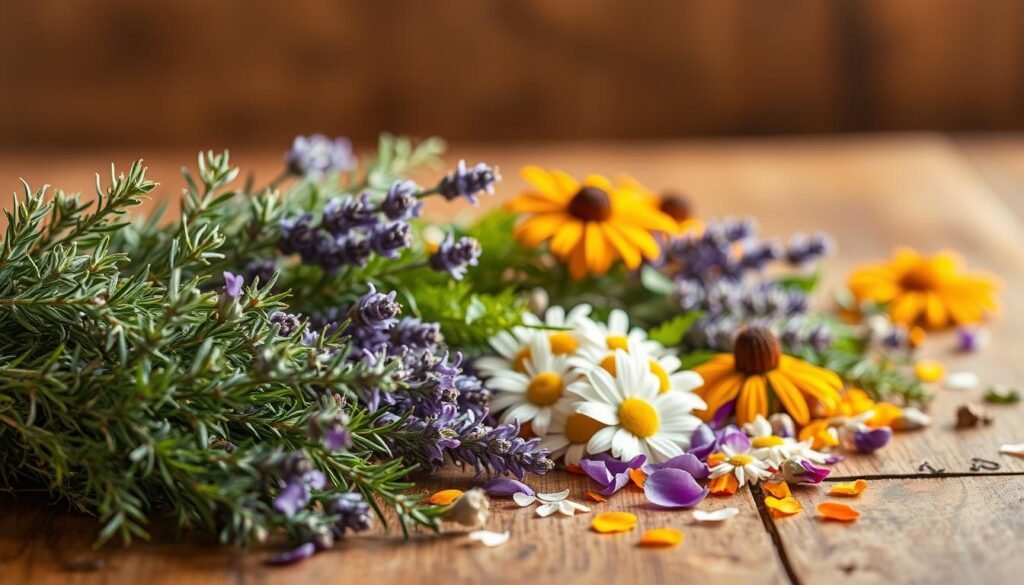
Lavender is renowned for its calming properties and is often used in herbal remedies to promote relaxation and improve sleep quality. Its soothing effects can also help alleviate pain and reduce inflammation.
Lavender thrives in well-drained soil and full sun. Harvest the flowers just as they begin to bloom for the most potent oil.
Chamomile is a gentle herb that soothes the digestive system and promotes relaxation. It’s also known for its anti-inflammatory properties, making it a versatile addition to any herbal remedy collection.
Chamomile prefers well-drained soil and partial shade. Harvest the flowers when they are in full bloom.
Calendula, or pot marigold, is celebrated for its ability to heal wounds and soothe skin irritations. Its antimicrobial properties make it an excellent ingredient in salves and creams.
Calendula grows well in most soils and full sun. Harvest the flowers when they are fully open.
| Herb | Physical Benefit | Growing Conditions |
|---|---|---|
| Lavender | Promotes relaxation, alleviates pain | Well-drained soil, full sun |
| Chamomile | Soothes digestion, promotes relaxation | Well-drained soil, partial shade |
| Calendula | Heals wounds, soothes skin irritations | Most soils, full sun |
| Echinacea | Boosts immune system | Rich soil, partial shade |
| Yarrow | Stops bleeding, reduces fever | Well-drained soil, full sun |
Echinacea is widely recognized for its ability to boost the immune system and fight off infections. It’s a popular ingredient in herbal supplements.
Echinacea prefers rich soil and partial shade. Harvest the roots in the fall for medicinal use.
Yarrow has been used historically to stop bleeding and reduce fever. Its antimicrobial properties make it a valuable herb for wound care.
Yarrow thrives in well-drained soil and full sun. Harvest the leaves and flowers during the summer.
By incorporating these healing spell herbs into your daily routine, you can enhance your physical wellness and protect against illness. Whether through teas, salves, or simply having them on hand, these herbs offer a natural and effective way to promote health.
Emotional and spiritual healing is a crucial aspect of overall wellness, and certain herbs can play a significant role in this process. In the practice of herbalism, various plants are utilized to support emotional balance and spiritual growth.
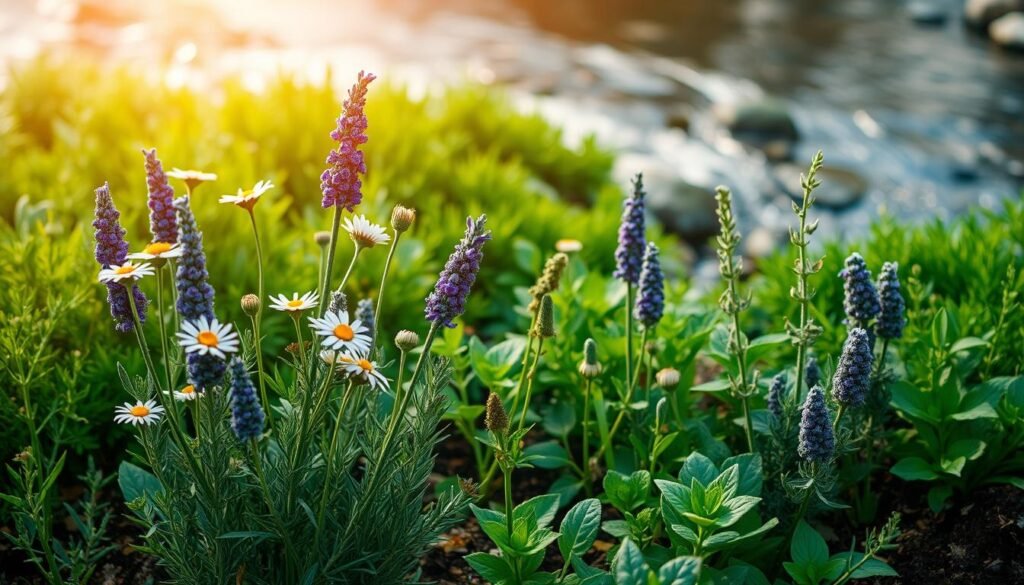
St. John’s Wort is renowned for its ability to lift the spirit and combat mild depression. Its bright yellow flowers are symbolic of sunshine and hope.
St. John’s Wort thrives in well-drained soil and full sun. Harvest the flowers and leaves when they are in bloom.
Mugwort is a versatile herb used in divination and dreamwork. It is believed to enhance psychic abilities and promote vivid dreams.
Mugwort prefers moist soil and partial shade. Harvest the leaves and stems before it flowers for the best potency.
Lemon balm is a calming herb that soothes the heart and uplifts the spirit. It is often used in teas and infusions to promote relaxation.
Lemon balm thrives in moist, well-drained soil and partial shade. Pinch off flower buds to encourage leaf growth.
Angelica is a protective herb believed to ward off negative energies and attract positive influences. It is often used in rituals for protection and healing.
Angelica prefers rich, moist soil and partial shade. Harvest the leaves and roots for use in spells and rituals.
Valerian root is a powerful sedative that promotes deep relaxation and peaceful sleep. It is used to calm the mind and body.
Valerian thrives in moist soil and partial shade. Harvest the roots in the fall after the plant has died back.
These herbs, when used appropriately, can significantly support emotional and spiritual healing. By incorporating them into your practice, you can foster a deeper sense of balance and well-being.
As we delve into the world of Healing Spell Herbs, it’s crucial to understand the importance of ethical harvesting and preservation methods. The effectiveness of these herbs in spellwork is significantly influenced by how they are harvested and preserved.
Sustainable harvesting is about respecting the natural balance and ensuring the long-term health of your magical herb garden. This involves harvesting herbs in a way that does not deplete the plant’s resources or harm the ecosystem. For instance, when harvesting leaves, it’s advisable to take them from the outside, allowing the inner leaves to continue growing. Never harvest more than a third of the plant at any given time to prevent causing it undue stress.
The timing of harvesting can significantly impact the magical potency of Healing Spell Herbs. Many practitioners believe that harvesting during certain lunar phases or planetary alignments can enhance the herbs’ magical properties. For example, harvesting during the full moon is thought to capture the peak potency of the herbs. Understanding the astrological influences on your herbs can help you time your harvest for maximum magical effect.
Once harvested, the method of drying and storage is crucial for preserving the magical potency of Healing Spell Herbs. Air drying is a popular method, as it preserves the herbs’ natural properties. Store the dried herbs in airtight containers, away from direct sunlight, to maintain their potency. Labeling your containers can help you keep track of the herbs and their intended uses.
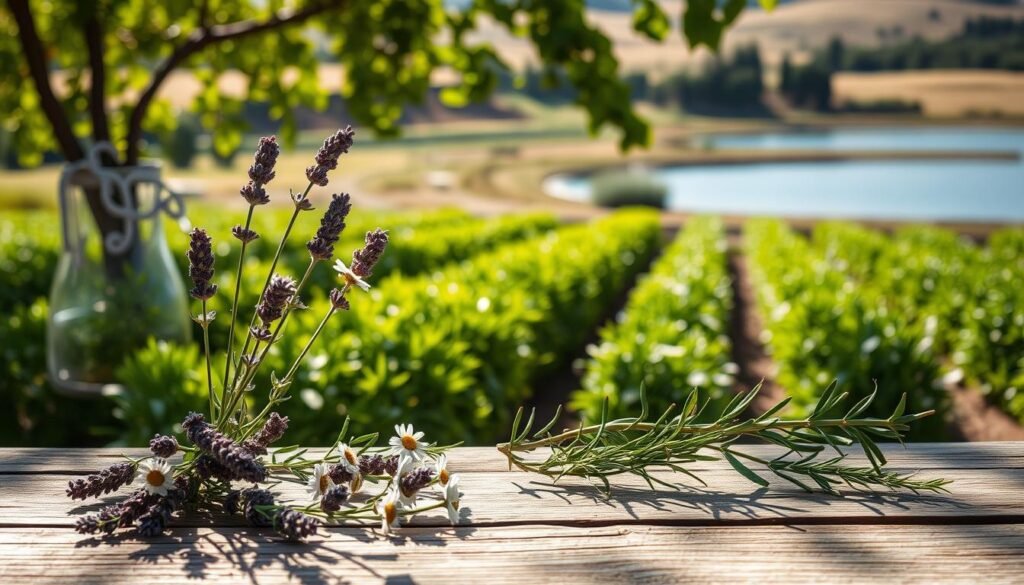
By adopting these practices, you not only ensure the longevity of your Healing Spell Herbs but also enhance their effectiveness in your spellwork. Ethical harvesting and preservation are integral to the responsible practice of herbal magic.
Now that you’ve cultivated your healing spell herbs, let’s dive into the magical practices that bring their potency to life. Crafting spells with homegrown herbs not only enhances their effectiveness but also deepens your connection to the natural world and your magical practice.
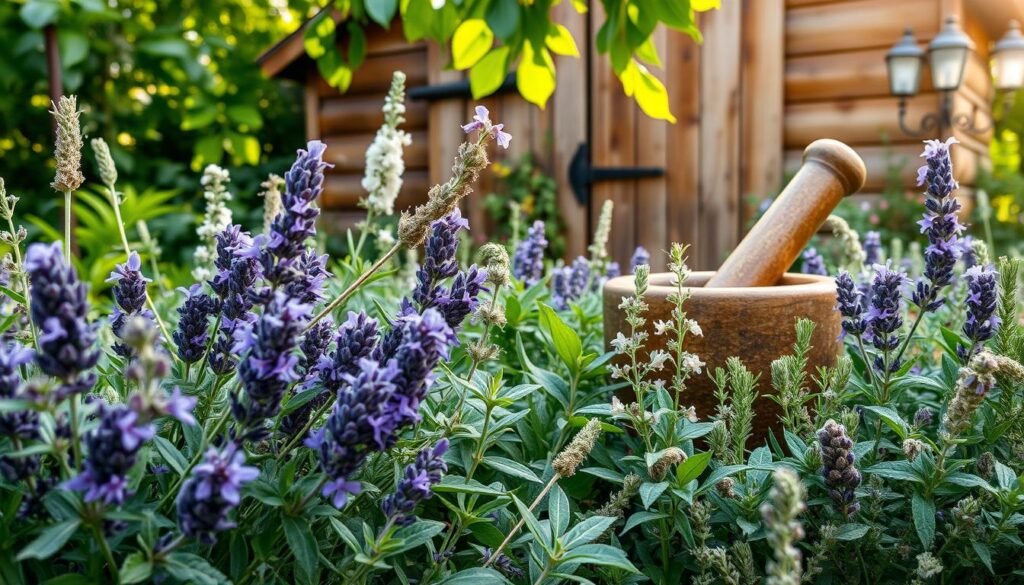
One of the simplest ways to incorporate your healing spell herbs into spellcraft is by creating protective sachets and charms. Fill small pouches or bags with dried herbs like rosemary or blackthorn, and hang them in your home or wear them as a charm to ward off negative energies.
Herbal teas and infusions are another powerful way to utilize your homegrown healing spell herbs. Steep herbs like chamomile or lavender in hot water to create calming teas, or use echinacea to boost your immune system. As you brew, focus your intentions on the desired outcome, whether it’s relaxation, protection, or healing.
Ritual baths and incense offer additional avenues for integrating your healing spell herbs into spellcraft. Add dried herbs or essential oils derived from your homegrown plants to your bath water for a purifying soak, or blend them into incense recipes to fill your space with sacred scents and energies.
Cultivating a magical connection through herbalism can be a deeply rewarding experience, allowing you to tap into the natural world and harness the power of Healing Spell Herbs. By incorporating these herbs into your practice, you can enhance your spells, rituals, and overall well-being.
As you continue on your journey with herbalism, remember to nurture your magical connection by being mindful of the energetic properties of the herbs you work with. This awareness will help you to create a more harmonious and balanced practice, fostering a deeper connection with the natural world.
By embracing the world of herbal witchcraft, you can deepen your understanding of the intricate web of life and the interconnectedness of all living things. As you explore the realm of Healing Spell Herbs and herbalism, you will discover new ways to enhance your magical workings and cultivate a more profound sense of magical connection.